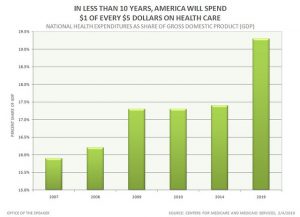The Future is Bright for X-ray Techs: Occupational Projections by the BLS

It is estimated that 9.8 million jobs will be added to the U.S. economy in the decade between 2014 and 2024. The projected increase in overall employment is 6.5 percent. Occupational projections by the BLS (U.S. Bureau of Labor Statistics) are for fastest job growth in healthcare, healthcare support, and technical occupations. If you are considering a career as a radiologic technologist, the future looks bright.
If you are already an X-ray tech, check out our job listings page.
What is Driving Growth in Healthcare Support?
The major factor driving the growth in healthcare support jobs is the changing demographics of the American population. For example, it is estimated that the prevalence of bone disease will increase substantially in the future as the American population ages. In the five decades between the years 2000 and 2050, the number of Americans 65 years and older is projected to increase from 35 million to 86 million. Similarly, the number of Americans 85 years and older will increase from 4 million to 20 million. The so-called “baby boomers,” people born after World War II, will be in their 70s and 80s and responsible for much of this increase.

Based on this change alone in the nation’s demographic profile, the number of people at risk of bone disease is projected to increase substantially. Data from NHANES estimates that by the year 2020 more than 10 million women and more than 3 million men in the United States will have osteoporosis of the hip. This is an increase of 35 percent and 43 percent, respectively, over the figures from 2002. As you know, individuals with hip osteoporosis have a high risk of hip fractures. They are likely to end up in a radiology department sooner or later. This one condition alone explains the growing need for healthcare support workers per the occupational projections by the BLS.
A Growing Need for Radiologic Technologists and DXA Operators
It is projected that by the year 2040 the substantially greater number of aging Americans could lead to a doubling or tripling in the number of hip fractures that occur in the United States every year. This would make it difficult to achieve the goals outlined by the Healthy People initiative, a program that outlines healthcare goals. In fact, history does not provide much cause for optimism. Healthy People 2000 set a target for a 15 percent reduction in the number of hip fractures in Americans 65 years and older. In fact, the incidence of hip fractures actually rose in the ensuing decade.
In 1988, the incidence of hip fractures was 714 per 100,000 annually. The Healthy People target for the year 2000 was for this number to drop to 607 per 100,000. In fact, the number rose by more than 17 percent to 840 per 100,000 by the year 2000. This is a concerning increase but it is an indicator to support the occupational projections by the BLS for job growth in the healthcare support sector.

Worldwide Projections for Healthcare Workers
The United States is not the only country in the world where an increasingly aging population is having a dramatic impact on the prevalence of healthcare conditions. Worldwide, the number of people aged 65 years and older in 1990 was 323 million. This number is projected to increase fivefold by the year 2050 to 1.55 billion. This change alone could drive the growth in healthcare support as per the occupational projections by the BLS.
There will be a more than threefold increase in the number of hip fractures from less than 2 million in 1990 to more than 6 million in 2050 worldwide. This is a conservative estimate at best because it assumes that for every age group the fracture rate will remain constant. The incidence of hip fractures has recently stabilized in North America and Europe. However, in other parts of the world, it continues to increase by as much as 3 percent annually. At this rate of increase, the number of hip fractures occurring each year worldwide could be more than 21 million in the year 2050. So, in addition to occupational projections by the BLS in the United States for healthcare support jobs, there is a growing need for these jobs worldwide.
The Future is Bright for X-ray Techs

Occupational projections by the BLS are a 23 percent increase in the healthcare support group. It is estimated that nearly 1 million new jobs will be added in the healthcare practitioner occupational group in the decade between 2014 and 2024. As noted, this is because of a skew in the country’s demographics with 38 percent of the population above age 55 in 2024. An older population has more healthcare needs. Also, with the federal health insurance reforms, a greater number of individuals have access to health insurance. This will drive the job growth in the healthcare support sector.
Incidentally, within the healthcare support group, occupational therapy assistants is the fastest growing occupation. There is a 43 percent projected increase in this occupation. It is also the highest paying at $57,000 per year. This is substantially higher than the median income for the healthcare support group ($26,000 per year). However, the highest level of education attained can greatly influence the pay scale.
Job Prospects for Radiologic and MRI Technologists
According to the BLS, the future is bright for X-ray techs. The median wage for radiologic technologists in 2018 was $59,000 per year. The median wage for MRI technologists in 2018 was $71,000 per year . The typical entry level education requirement is an associate’s degree. There were about 241,000 jobs in this occupational group in 2016. There is an expected employment change of 30,000 additional jobs between 2016 and 2026.
X-ray Continuing Education
We offer a range of online courses for X-ray techs to complete their biannual continuing education requirements for the ARRT® and other national and state-level registries. All courses on our site offer category A credits which are good for your ARRT® CE requirements*, and are accepted by NMTCB, ARDMS, SDMS, every US state and territory, Canadian province, and all other Radiologic Technologist, Nuclear Medicine, and Ultrasound Technologist registries in North America, for both full and limited permit technologists, guaranteed. Our courses range from 1 credit to 24 credits and you have the flexibility to choose the number and type of credits you need. Our bone densitometry e-book and test is worth 23 credits and is good to meet general radiography CEUs and DXA CE credits in all 50 states and Canada.